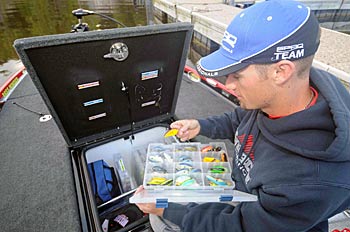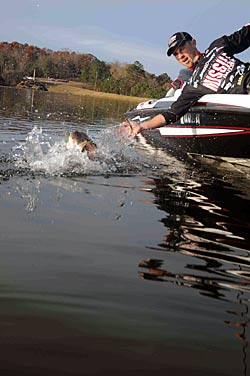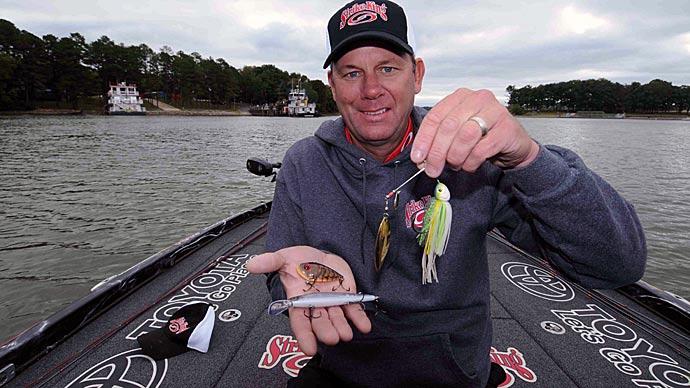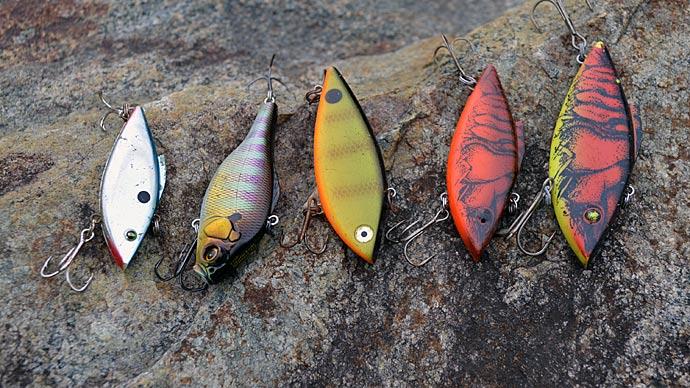
Bass anglers must take a multiple choice quiz when selecting lures for the prespawn.
Changing weather and water conditions combined with bass in transition make it challenging to pick the right lure each day to catch prespawn fish. Bassmaster Elite Series pro John Crews has taken this test numerous times on the tournament trail and has frequently relied on three lures to trick prespawn bass. His top three choices for the prespawn are a Spro Little John 50 crankbait, Spro McStick 110 suspending stickbait, and Missile Baits Ike’s Mini Flip Jig with a Missile Baits Baby D Bomb trailer.
“The crankbait is something you can cover a lot of water with, especially if you get some stained water,” Crews says of his top choice. “You can eventually put together a pattern whether bass are on secondary points or towards the back of the pockets. You can also cover a lot of water with it and catch fish periodically.” Crews opts for the jerkbait when fishing clearer water, and he likes the jig for fishing in any water condition.
Crews offers the following tips on how to catch bass on his favorite prespawn lures.
Little John 50 Crankbait
The Virginia pro wants his crankbait to imitate a crawfish, so he favors yellow, red, brown, and black/chartreuse for his lure colors. His favorite crankbait color for the Little John 50 is spring craw.
The crankbait works best for Crews in stained water and on days with a bit of wind or cloudy skies. He likes to run the crankbait in a depth range of 2 to 6 feet along a 45-degree bank, channel swing in the back of a pocket, or some transition bank where the rock changes from one type to another.
The touring pro believes it is essential to make a long cast with the crankbait, which he achieves by throwing it on 12-pound Sunline Crank FC line with a 7-foot Cashion John Crews Signature Square Bill Rod and a 6.4:1 gear ratio baitcast reel. Positioning his boat parallel to the bank allows Crews to bump his crankbait along the bottom for 60 to 70 percent of his retrieve. Crews changes up his retrieve until he determines how bass want the lure presented. “Sometimes they want it a little bit slower, and sometimes they want it a little bit faster,” he says. “Sometimes, they will want it starting and stopping.”
Covering as much water as possible is the key to fishing a crankbait for prespawn bass. “A lot of people get hung up on thinking the fish are on the secondary points or in the backs of pockets,” Crews says. He suggests you go down a bank with the crankbait and let the fish tell you where they are staging.
McStick 110 Suspending Stickbait

Crews notes a McStick 110 in the Ayu Shad hue is “money” for him when fishing clear water in the early spring. His favorite McStick color for stained water is Cell Mate.
“Sun and wind are usually perfect for a jerkbait,” Crews says. Ideal spots for throwing the McStick are secondary points, main lake bluffs, bluff banks in creek coves, and boat docks. He likes to fish the McStick from depths of 4 to 15 feet for prespawn bass either suspended or holding close to the bottom. He believes bottom-hugging bass will rise to hit the stickbait because the fish have been feasting on dying shad throughout the winter.
Crews employs a jerk-and-pause retrieve with the McStick. “After I make a cast, I will do three or four cranks of the reel handle to get the bait going, and then I will jerk it on a slack line,” he says. “Usually, I will do two or three jerks and then a pause. I will vary the pause from one or two seconds to five or six seconds. That is about as long as I can stand it.” He lengthens the pause in colder water but moves the lure faster with shorter pauses when the water is warming, and bass become more active. His gear for fishing the McStick consists of a 6-foot, 9-inch Cashion medium-heavy action rod with a soft tip and a 6.4:1 baitcast reel filled with 12-pound Sunline Super FC Sniper line.
According to Crews, using a McStick that suspends or slowly sinks is the key to catching prespawn bass. He suggests using a suspending model when fishing shallow to prevent the lure from hanging up on the bottom. A slow-sinking McStick is best for deeper water because it allows the lure to descend into a bass’ strike zone.
Ike’s Mini Flip Jig and Baby D Bomb
Crews likes a tint of orange on his jig and trailer combination to tempt prespawn bass. His favorite jig color is Bamer Craw (brown and orange), and he suggests Bruiser (black and blue) is a good jig color for dirty water. For early spring bass, Crews likes the Desert Storm (green pumpkin with orange swirl) on his Baby D Bomb and will also use a green pumpkin D Bomb throughout the prespawn. He mostly opts for a 3/8-ounce jig but sometimes upgrades to a 1/2-ounce version.
The jig produces prespawn bass in any water color and nearly any weather condition. He likes to fish it 2 to 20 feet deep around any type of cover. “The good thing about a jig is that you can skip it up under docks,” Crews says.
The 11-time Bassmaster Classic qualifier likes to cast the jig on rocky banks, under and around docks, and in spots where he caught some bass on crankbaits. He casts the jig on 14- or 16-pound Sunline Shooter Fluorocarbon with a 7-foot, 2-inch Cashion John Crews Signature Worming Rod and high-speed baitcast reel (7.0:1 or 8.0:1 gear ratio).
“I will throw it out there, and then I will kind of drag it to try and keep it in contact with the bottom as much as possible,” Crews says. Maintaining bottom contact is the key to presenting the jig properly. Hence, Crews advises keeping your rod tip down and sweeping the rod in the same fashion as working a Carolina rig to catch bottom-hugging prespawn bass.
BassResource may receive a portion of revenues if you make a purchase using a link above.




